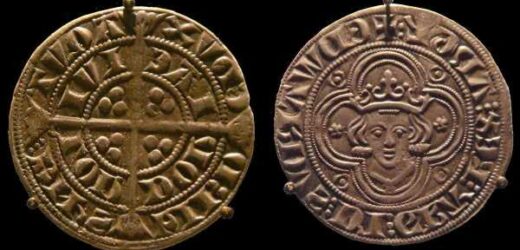WW2: Metal detectorists find grenades in Netherlands lake
We use your sign-up to provide content in ways you’ve consented to and to improve our understanding of you. This may include adverts from us and 3rd parties based on our understanding. You can unsubscribe at any time. More info
Metal detectorists have unearthed what may be the “largest mediaeval coin hoard” ever found in Scotland, with 8,407 coins that together are likely worth hundreds of thousands of pounds of the antiquities market. The substantial treasure trove — which includes hundreds of silver pieces from both Britain and Europe — was discovered last year near the village of Dunscore in Dumfriesshire. The majority of coins in the hoard, officials revealed, are Edward I and II pennies that date back to the 13th and 14th centuries. Work is underway to fully catalogue the finds.
In Scotland, the Treasure Trove Unit for the Queen’s and Lord Treasurer’s Remembrancer is responsible for logging new archaeological finds. Their goal is to record and preserve relevant objects for the public good.
An expert source told the Scottish Mail on Sunday: “This is an absolutely amazing find. After the initial discovery, the site was excavated by Treasure Trove Unit officials along with National Museums Scotland archaeologists.”
They continued: “Now each coin is being catalogued. This requires identifying, photographing, measuring and weighing each one.”
A spokesperson for the Treasure Trove Unit added: “The Dunscore Hoard is one of the largest mediaeval coin hoards found in Scotland since the 19th century. It contains a mixture of Scottish, English, Irish and continental silver coins.”


The Dunscore Hoard was unearthed just 20 miles from Balmaghie, where the so-called Galloway Hoard was unearthed in 2014. This trove is regarded as the finest collection of Viking Age objects ever found in Britain — and was valued at nearly £2million.
The Dunscore Hoard is part of a massive collection of treasure unearthed in Scotland after metal detecting saw a boom in popularity during the pandemic. The hobby is an ideal Covid-era pastime, being as it is a solitary outdoor activity.
According to the authorities, newly discovered artefacts are now being handed in at a rate of more than 200 objects each week. In fact, the sheer volume of finds over the last couple of years has meant that the Treasure Trove Unit has required more staff.
A Crown Office report published earlier this year noted that “given lockdown issues and an increased public interest in using metal detectors, there is a significant backlog of recovered artefacts awaiting appraisal.” In fact, the Treasure Trove Unit has reported taking a whopping 12,263 objects this year — including 900 since October alone.


For comparison, there were only 1,551 artefacts logged across the whole of 2019. At present, the backlog of objects due review stands at more than 5,000 items.
Under Scottish law, any newly-discovered artefact believed to be of archaeological significance — whether made from precious metals or not — technically belongs to the Crown and must be reported to the authorities. The Crown, however, does not always exercise its claim.
The decision is made by the King’s and Lord Treasurer’s Remembrancer based on the advice of the Scottish Archaeological Finds Allocation Panel. When a claim is exercised, a payment, known as an “ex gratia award”, is given to the finder.
The law is slightly different in England, Wales and Northern Ireland, where the Treasure Act of 1996 applies. Under the act, Treasure is defined as any object that is at least 300 years old and at least 10 percent of which is made up of either gold or silver.
DON’T MISS:
Rolls-Royce could swerve Putin’s nuclear grip, expert says [INSIGHT]
Mystery of British submarine that vanished in WW2 may have been solved [REPORT]
Warning over ‘contagious’ virus in feared tripledemic worse than Covid [ANALYSIS]

The rules for coins under the Treasure Act are different, with coins being defined as treasure if there are at least two coins dating back at least 300 years, unless they contain less than 10 percent gold or silver, in which case there must be at least 10 coins in the find to qualify.
Other objects considered treasure include two or more prehistoric base metal objects found in association with each other and deliberately hidden items that are less than 300 years old and substantially made up of gold or silver whose owners or heirs cannot be determined.
The act also covers items found in association with any other object considered treasure. After reporting a possible treasure and handing it over to the local coroner, an inquest is held to determine whether or not the object or objects meet the above criteria.
If the item is found to be a treasure, the finder is obligated to offer it for sale to a museum. The sale price is set by a board of independent experts known as the Treasure Valuation Committee.
Source: Read Full Article


